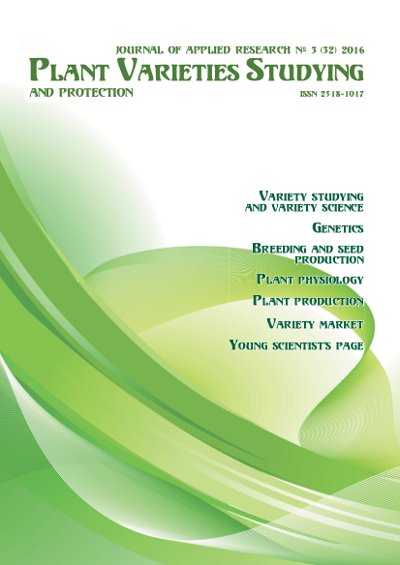Physiological role of amino acids in the nutrition of highly productive varieties of winter wheat
DOI:
https://doi.org/10.21498/2518-1017.3(32).2016.75980Keywords:
winter wheat, amino acids, nutrients, productivityAbstract
Purpose. To define the role of fertilizers containing amino acids in the nutrition systems of highly productive varieties of winter wheat.
Methods. Field studies, biochemical technique, analytical procedure, statistical evaluation.
Results. In the process of investigations, sufficiently high activity of fertilizers containing amino acids was established when applying them for leaf-feeding. Fertilizers based on algae (Megafol, Megafol Protein, Terra-Sorb foliar) and animal (Izabion) hydrolysates appeared to be very effective for increasing yield of culture. It was found that in case of low doses of mineral nitrogen, fertilizers helped to increase both the yield and quality indicators of high-yielding wheat variety.
Conclusions. It was defined that fertilizers that include amino acids are highly effective compositions containing plant-available nitrogen in organic form and can be promising for application as antistress agents and improving efficiency of macro- and microelements use by cultivated plants. They are essential components of modern technologies for cultivation of highly productive varieties and hybrids in crop production of Ukraine.
Downloads
References
Morgun, V. V. (2014). Abundant bread supply and food security. Svit [World], 35–36, 2–3. [in Ukrainian]
Morgun, V. V., Shvartau, V. V., & Kiriziy, D. A. (2015). Physiological basis for the formation of high productivity of cereals. Fiziologiya i biokhimiya kul’turnykh rasteniy [Physiology and biochemistry of cultivated plants], 42(5), 371–392. [in Russian]
Fedoroff, N. V. (2015). Food in a future of 10 billion. Agric & Food Secur, 4, 1–11. doi: 10.1186/s40066-015-0031-7
Morgun, V. V., Sanin, Ye. V., & Shvartau, V. V. (2015). Klub 100 tsentneriv. Suchasni sorty ta optymalni systemy zhyvlennia y zakhystu ozymoi pshenytsi [100 Zentner Club. Modern varieties and optimal systems of winter wheat nutrition and protection]. (Iss. IX). Kyiv: Lohos. [in Ukrainian]
Hayat, S., Hayat, Q., Alyemeni, M. N., Wani, A. S., Pichtel, J., & Ahmad, A. (2012). Role of proline under changing environments. Plant Signal Behav, 7(11), 1456–1466. doi: 10.4161/psb.21949
Ben Rejeb, K., Abdelly, C., & Savouré, A. (2014). How reactive oxygen species and proline face stress together. Plant Physiol. Biochem., 80, 278–284. doi: 10.1016/j.plaphy.2014.04.007
Szabados, L., & Savouré, A. (2009). Proline: a multifunctional amino acid. Trends Plant Sci, 15(2), 89–97. doi: 10.1016/j.tplants.2009.11.009
Alcázar, R., Marco, F., Cuevas, J. C., Patron, M., Ferrando, A., Carrasco, P., Tiburcio, A. F., & Altabella, T. (2006). Involvement of polyamines in plant response to abiotic stress. Biotechnol. Lett., 28(23), 1867–1876. doi: 10.1007/s10529-006-9179-3
Bulgari, R., Cocetta, G., Trivellini, A., Vernieri, P., & Ferrante, A. (2015). Biostimulants and crop responses: a review. Biologiсal Agriculture & Horticulture, 1(31), 1–17. doi: 10.1080/01448765.2014.964649
Petrozza, A., Santaniello, A., Summerer, S., Di Tommaso, G., Di Tommaso, D., Paparelli, … Cellinia, F. (2014). Physiological responses to Megafol® treatments in tomato plants under drought stress: A phenomic and molecular approach. Scientia Horticulturae, 174, 185–192. doi: 10.1016/j.scienta.2014.05.023
Hammad, S. A. R., & Ali, O. A. M. (2014). Physiological and biochemical studies on drought tolerance of wheat plants by application of amino acids and yeast extract. Annals of Agricultural Sciences, 59(1), 133–145. doi: 10.1016/j.aoas.2014.06.018
Santaniello, A., Giorgi, F. M., Di Tommaso, D., Di Tommaso, G., Piaggesi, A., & Perata, P. (2013). Genomic approaches to unveil the physiological pathways activated in Arabidopsis treated with plant–derived raw extracts. Acta Hortic., 1009, 161–174. doi: 10.17660/ActaHortic.2013.1009.20
Ziosi, V., Zandoli, R., Di Nardo, A., Biondi, S., Antognoni, F., & Calandriello, F. (2013). Biological activity of different botanical extracts as evaluated by means of an array of in vitro and in vivo bioassays. Acta Hortic., 1009, 61–66. doi: 10.17660/ActaHortic.2013.1009.5
Dospekhov, B. A. (1985). Metodika polevogo opyta (s osnovami statisticheskoy obrabotki rezul’tatov issledovaniy) [Methods of field experiment (with the basics of statistical processing of research results)]. (5nd ed., rev.). Moscow: Agropromizdat. [in Russian]
Downloads
Published
How to Cite
Issue
Section
License
Copyright (c) 2016 Plant varieties studying and protection

This work is licensed under a Creative Commons Attribution-ShareAlike 4.0 International License.
Our journal abides by the CREATIVE COMMONS copyright rights and permissions for open access journals.
Authors, who are published in this journal, agree to the following conditions:
1. The authors reserve the right to authorship of the work and pass the first publication right of this work to the journal under the terms of a Creative Commons Attribution License, which allows others to freely distribute the published research with the obligatory reference to the authors of the original work and the first publication of the work in this journal.
2. The authors have the right to conclude separate supplement agreements that relate to non-exclusive work distribution in the form in which it has been published by the journal (for example, to upload the work to the online storage of the journal or publish it as part of a monograph), provided that the reference to the first publication of the work in this journal is included.


























 Ukrainian Institute for Plant Varieties Examination
Ukrainian Institute for Plant Varieties Examination  Селекційно-генетичний інститут
Селекційно-генетичний інститут Institute of Plant Physiology and Genetics of the National Academy of Sciences of Ukraine
Institute of Plant Physiology and Genetics of the National Academy of Sciences of Ukraine
 The National Academy of Agrarian Sciences of Ukraine
The National Academy of Agrarian Sciences of Ukraine